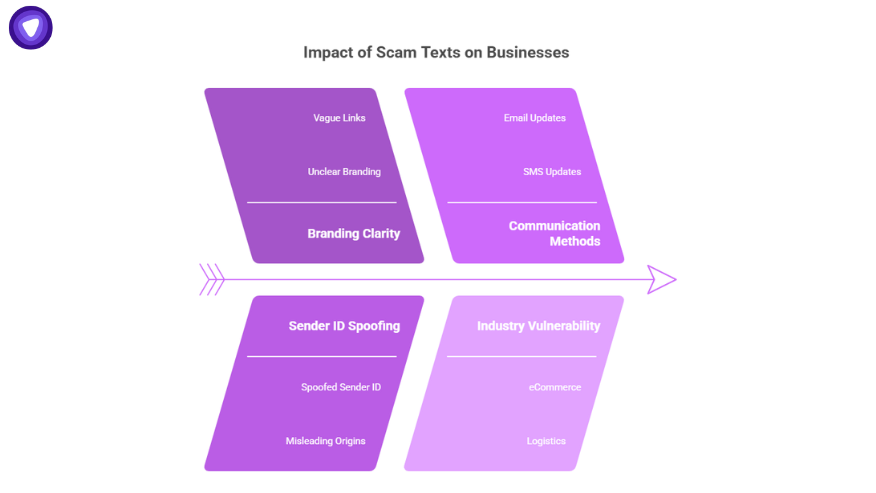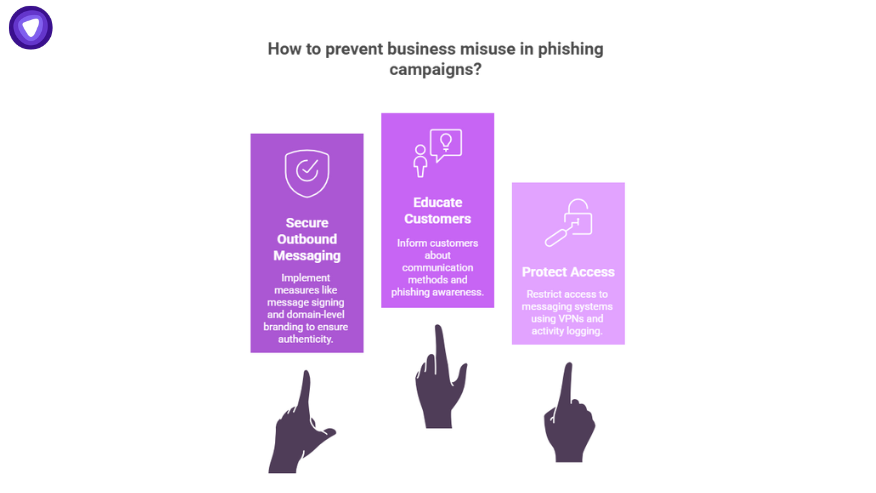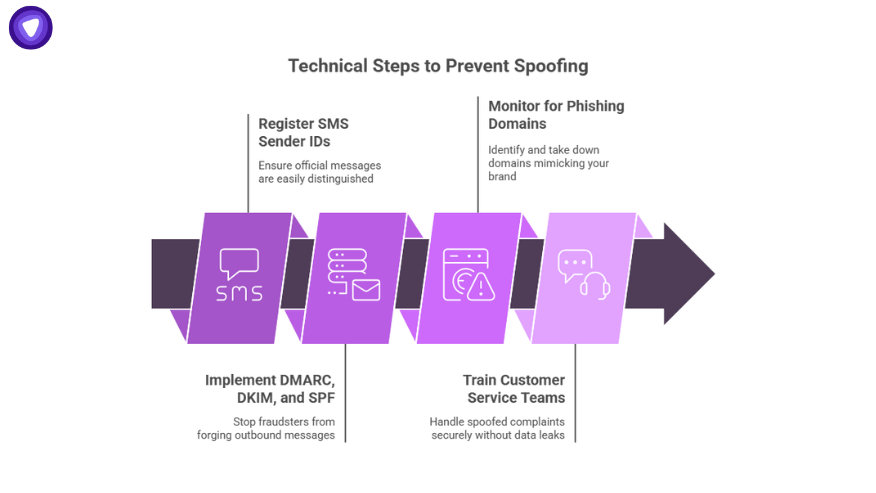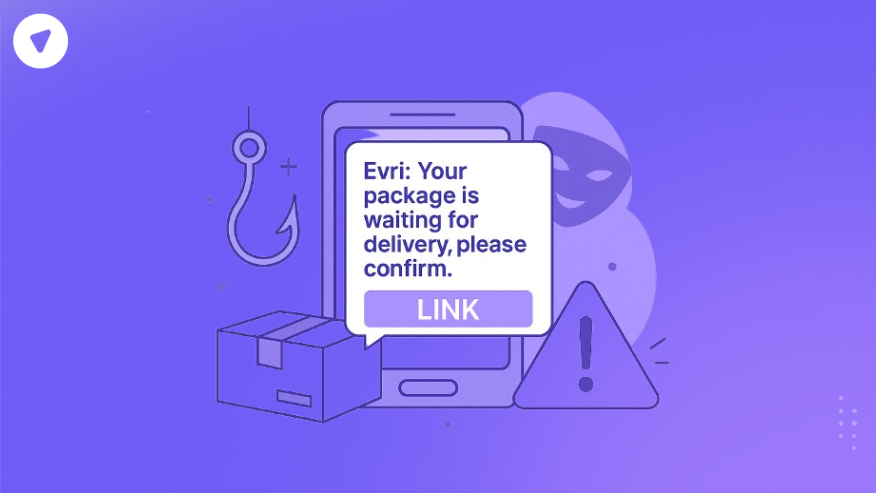If you receive a text from Evri asking you to pay for redelivery or click on a suspicious link, it’s a scam. Do not click the link, do not reply. Forward the message to 7726, report it to phishing@evri.com, and only track parcels through the official evri.com website.
Scammers continue to impersonate Evri to steal money and personal information. In 2024 alone, UK authorities took down more than 12,000 fake Evri scam domains, and experts now rank parcel delivery scams as the fastest-growing phishing threat in the UK. These texts often appear urgent, claiming a failed delivery or small fee, but they are designed to compromise your accounts and finances.
This guide explains how these scam texts work, how to recognize them, and the exact steps you should take to protect yourself and your business from brand impersonation attacks.
What Is an Evri Scam Text?
An Evri scam text is a fake message that appears to come from Evri, a real UK-based parcel delivery company. These messages often tell the recipient that there’s a missed delivery, a failed payment, or a reschedule required.
The goal? Trick you into clicking a link that takes you to a spoofed website designed to steal your personal information or payment details.
As of July 2025, Evri has issued multiple warnings about fake text messages, confirming that they never request redelivery fees or payments via SMS. UK police and Action Fraud have also flagged parcel delivery scams as one of the fastest-growing phishing threats targeting consumers and businesses.
Here are some real-world scam examples:
- “Evri: Your parcel could not be delivered. Please reschedule here: [fake link]”
- “Evri Express Delivery Exception Notification – £1.45 fee required”
- “Your Evri parcel has been delayed. Track delivery here: [non-Evri URL]”
The scam messages often look professional and are timed around common delivery hours. They’re frequently sent from anonymous mobile numbers or via WhatsApp.
Some recent cases have involved Vedearth Evri WhatsApp messages — adding a layer of confusion by imitating Evri customer service through group chats or chatbots.
How to Spot an Evri Scam Text: The Red Flags
| Feature | Scam Text Example | Real Evri Message |
|---|---|---|
| Payment | “Pay £1.45 to redeliver your parcel” Scam texts often ask for small redelivery fees. | Evri never asks customers to pay for redelivery via text. |
| Link | evri-update.delivery-check.info Non-official links with random domains are scams. | Official links always start with https://www.evri.com |
| Sender ID | Random mobile number or unknown ID Scam messages come from non-verified numbers. | Verified Evri sender ID used for legitimate notifications. |
| Tone | Urgent, threatening, or claiming missed delivery Scams pressure you to act fast. | Calm, straightforward updates about your delivery status. |
To spot an Evri scam text message, watch for these signs:
1. Generic Greetings
Scammers usually avoid using your name. If the message begins with “Dear Customer” or “Hi” with no personal detail, be skeptical.
2. Strange URLs
Real links from Evri will usually start with https://evri.com or https://evri.link. Scam links may use domains like:
- evri-update.com
- evri.re-schedule.xyz
- deliver-now.info
3. Spelling Errors or Awkward Wording
Misspellings like “rescedule” or odd phrasing (“Your delivery is on the back”) are common giveaways.
4. Urgent Payment Requests
Evri does not charge to reschedule a delivery. Any message demanding payment is fake.
5. WhatsApp or Mobile Senders
Evri does not use WhatsApp to send delivery notices. Any Vedearth Evri WhatsApp messages are scams.
What to Do If You Receive a Scam Message?
Never click links or download attachments in suspected scam texts or emails.
Avoid replying to the message; scammers may use responses to validate your contact.
Forward scam emails to phishing@evri.com or scam SMS to 7726.
After reporting, delete the message to prevent accidental clicks.
Check your real Evri account or contact customer support to confirm delivery status.
If you receive an Evri scam text, follow these steps:
1. Do Not Click the Link
This could lead to a fake site designed to steal your personal info or infect your device.
2. Do Not Reply
Even a simple “stop” reply can confirm your number is active — which may invite more scam messages.
3. Report the Message
- Forward the text to 7726 (free scam SMS reporting service in the UK)
- Email it to phishing@evri.com
4. Delete the Message
Once reported, delete it from your device. If you clicked the link, run an antivirus scan and monitor your accounts.
5. Verify on the Official Site
Only use the official Evri website (https://www.evri.com) to track parcels or manage deliveries.
Why This Problem Hurts Businesses Too?

These scam texts don’t just affect individuals — they create collateral damage for legitimate brands and businesses, especially those in:
- eCommerce
- Logistics
- SaaS with delivery integrations
- Retail platforms
- CRM and marketing automation tools
If your company sends SMS or email updates to customers, there’s a risk you could be mistaken for the scammer — especially if branding or links aren’t crystal clear.
Some businesses have even had scam messages spoof their own sender ID, making it look like the scam originated from them.
How Businesses Can Prevent Being Misused in Phishing Campaigns?

Here’s how you can protect your business from getting caught in the scam net:
Secure Your Outbound Messaging
Use platforms that:
- Sign messages
- Include domain-level branding
- Track clicks via custom subdomains
Educate Customers
Let users know how your company communicates:
- Add disclaimers in messages
- Share phishing awareness emails
- Add “Verify on our website” CTAs
Protect Access to Messaging Systems
Ensure only verified staff or systems can send customer communications. The easiest way? Lock down access using VPNs, device control, and activity logging.
Stay Connected & Learn With Us
Join our growing community and connect with peers who build secure networks and resell privacy tools worldwide.
Technical Steps for Businesses to Prevent Spoofing

Parcel delivery and logistics companies are frequent targets of spoofing attacks. To protect your brand and customers, businesses should take these technical security measures:
- Register SMS sender IDs with telecom providers to ensure official messages are easily distinguished from spoofed ones.
- Implement DMARC, DKIM, and SPF records on all business email domains to stop fraudsters from forging outbound messages.
- Continuously monitor for phishing domains that mimic your brand (e.g., evri-delivery-check.com) and take them down through domain registrars or law enforcement.
- Train customer service teams to identify spoofed customer complaints and handle them securely without leaking additional data.
These steps make it harder for scammers to impersonate legitimate parcel companies and help maintain customer trust.
How PureVPN White Label Helps Secure Messaging Workflows?
While PureVPN is not a delivery platform, we secure the infrastructure that powers them.
If your platform:
- Sends delivery or transactional messages
- Hosts dashboards that manage customer contact info
- Offers APIs that trigger notifications
Then you need to control who has access — and from where.
PureVPN White Label gives you:
- A branded VPN app to gate backend services and panels
- IP and device filtering
- Admin-level controls for login visibility and usage
- API and SDK access for embedding VPN connections directly into your tools
Don’t wait until scammers spoof your workflows. Lock down the access now.
Final Thoughts: Protect Customers and Infrastructure
The rise of Evri scam texts is just one symptom of a larger issue: phishing is getting smarter, faster, and more believable.
Whether you’re a consumer or a company — vigilance is now part of daily operations.
For individuals:
- Don’t trust any message asking for payment
- Use official websites for all tracking
- Report suspicious texts
For businesses:
- Be proactive
- Audit your communication channels
- Secure your access layer with VPNs and role control
Because when it comes to digital trust, prevention beats damage control — every single time.


